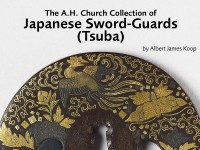The A. H. Church Collection of Japanese Sword-Guards (Tsuba)
An unpublished catalogue of the A. H. Church collection of Japanese sword-guards (tsuba) by Albert James Koop.

Publications online: 1264 objects
Tsuba with chrysanthemoid florets and sword-blades
-
Literature notes
The front chrysanthemoid, with 16 sunk florets, each paved with aogai lacquer (comminuted pearl-shell); actually the intervals between the florets are ken blades with obtuse points, continuing across the sd.; a similar description applies to the back, except that both the lacquer and the chrysanthemum idea are absent, and there is an inner ring of [Figure] shapes linking blades together. -
Details
- Associated place
- Date
- 17th century (1601 - 1700)
- Material and technique
- obverse and reverse: iron; tang-hole plugged with soft metal, probably copper obverse: partially covered in lacquer, and inlaid with aogai
- Dimensions
- 7.9 x 7.8 cm (height x width)
- Material index
-
processed material › metal › iron,organic › animal › shell › pearlshell,
- Technique index
- Object type index
-
arms/armour › koshirae › kodogu › tsuba
- No. of items
- 1
- Credit line
- Bequeathed by Sir Arthur H. Church, 1915.
- Accession no.
- EAX.11195
-
Further reading
Koop, Albert James, The A. H. Church Collection of Japanese Sword-Guards (Tsuba), 3 vols (Oxford, Ashmolean Museum, 1929), no. 1195
Glossary (2)
lacquer, tsuba
-
lacquer
Chinese and Japanese lacquer is made from the sap of the lacquer tree, which is indigenous to Eastern China. It is applied to wood as a varnish or for decorative effect. In India and the Middle East, lacquer is made from the deposit of the lac insect.
-
tsuba
Japanese sword guard.
Location
-
- currently in research collection
Objects are sometimes moved to a different location. Our object location data is usually updated on a monthly basis. Contact the Jameel Study Centre if you are planning to visit the museum to see a particular object on display, or would like to arrange an appointment to see an object in our reserve collections.
Publications online
-

The A. H. Church Collection of Japanese Sword-Guards (Tsuba)
The front chrysanthemoid, with 16 sunk florets, each paved with aogai lacquer (comminuted pearl-shell); actually the intervals between the florets are ken blades with obtuse points, continuing across the sd.; a similar description applies to the back, except that both the lacquer and the chrysanthemum idea are absent, and there is an inner ring of [Figure] shapes linking blades together.
Notice
Object information may not accurately reflect the actual contents of the original publication, since our online objects contain current information held in our collections database. Click on 'buy this publication' to purchase printed versions of our online publications, where available, or contact the Jameel Study Centre to arrange access to books on our collections that are now out of print.
© 2013 University of Oxford - Ashmolean Museum

